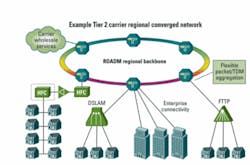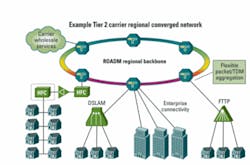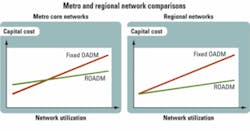by Paul R. Morkel
Reconfigurable optical add/drop multiplexers (ROADMs) create a very efficient service provider network infrastructure, enabling high-bandwidth circuits to be established quickly and cost-effectively with minimal manual intervention. ROADMs absolve concerns over operational complexity and costs, long-term scalability, and stranded assets and investment.
Until recently, ROADM deployments among Tier 2 service providers such as competitive local exchange carriers (CLECs), independent operating companies (IOCs), and utilities had been limited by capital expenditure (capex) concerns and differences in network requirements. However, with widespread deployment among Tier 1 carriers and multiservice operators (MSOs), ROADM technology has matured into a cost-effective, staple element of optical networks. Along with the growth in traffic demands driven by residential broadband roll-outs, this has spurred ROADM deployment among Tier 2 service providers, as they seek to stem the increase in fixed-network costs and competitively accommodate growth in traffic demand.
Varied benefits, varied users
ROADM technologies offer benefits that have made them increasingly popular among a variety of network operators.
ROADMs implement miniaturized parallel optical switching elements to manage optical signals as fast as 40 Gbits/sec per wavelength between endpoints on optical networks. High-bandwidth connections can be remotely established, without manual intervention or intermediate conversion of traffic between WDM channels and electronic signals.
These capabilities translate into significant savings in time and money for network operators who might otherwise use fixed OADMs. Network planning and operations are simplified and opportunities to incorrectly configure equipment based on manual fiber connections can be minimized. Installation tasks, management burden, and truck rolls are reduced, and service introduction is streamlined. Furthermore, in many cases, intermediate equipment for regenerating signals can be eliminated.
Research and education institutions were among the earliest adopters of ROADMs. For these users, the primary appeal of ROADMs is dynamic reconfigurability -- the ability to cost-effectively establish high-bandwidth wavelength connections as needed among partner institutions for short-term grid computing and e-science projects.
Tier 1 carriers and MSOs, on the other hand, have sought ROADMs even for fixed traffic requirements within transport infrastructure, especially where new services such as video applications carried over Ethernet are being introduced. DWDM provides a highly scalable optical transport method with efficient, direct Ethernet adaptation to wavelengths, obviating intermediate SONET/SDH infrastructure. ROADMs enable an operationally elegant approach to deploying DWDM while simultaneously lowering ongoing network costs and increasing transmission path performance. Tier 1 carriers and MSOs have widely deployed ROADM technologies where until quite recently they might have installed fixed OADMs.
Reaching Tier 2 service providers
The establishment of ROADM technology as a key element in the current infrastructure of Tier 1 carriers and MSOs has turned up the pressure on Tier 2 service providers to follow suit. Tier 2 providers must match the capabilities of their larger competitors to cost-effectively offer the same services to their customers. The bandwidth drivers for this community of operators are largely the same as for Tier 1 carriers and MSOs: next-generation services such as high-speed Internet, video distribution, video-on-demand, teleworking, video conferencing, online gaming, and e-commerce.
There's additional incentive for rural telcos in the United States to enhance their infrastructures. The U.S. Rural Utilities Service (RUS) offers low-interest financing on approved equipment to encourage rural service providers to introduce competitively priced, next-generation services in remote areas and to minimize any "digital divide" between rural users and those based in large metropolitan areas.
Beyond the motivation of competitive pressure and government incentive, however, Tier 2 service providers are deploying ROADMs because the enhanced economies of scale, service and traffic support, and cost efficiencies extended by the technology best position an operator for the ebbs and flows of the marketplace.
Economics and topologies
The fact that Tier 2 service providers operate different business models and network architectures than those of Tier 1 carriers and MSOs means that their ROADM technology needs will often vary. In architecture, Tier 2 networks are often characterized by a variety of access technologies such as hybrid fiber/coax (HFC), DSL, and fiber-to-the-premises (FTTP) networks -- all operating to serve specific communities that must all be supported by a common transport backbone. In addition, providing intercarrier wholesale services is common among Tier 2 carriers.
Tier 2 providers typically operate flatter, less hierarchical networks of simpler topologies -- with fewer interconnected rings and mesh configurations. However, the networks may be of substantially larger geographic scope and greater node count per ring -- but with less traffic, depending on population densities. This leads to different criteria for deployments and different opportunities to optimize and manage capital costs.
By optimizing for longer, thinner routes with reduced multiring-interconnectivity, Tier 2 service providers take a cost-effective approach to meeting their ROADM needs. Figure 1 shows a typical Tier 2 network application where multiple services are transported across a converged, flat optical transport network. DWDM technologies with flexible muxponders for service aggregation provide the ideal approach for multiservice convergence, including wholesale bandwidth services.
Figure 1. Tier 2 converged networks tend to be flatter than those of Tier 1 carriers and MSOs. ROADM technology can provide several benefits in these architectures.
Another important factor is that Tier 2 service providers will often serve lower-density markets than do Tier 1 providers and generally face complex investment decisions for new technologies based on return-on-investment criteria. The great news for the Tier 2 community on this front is that ROADM cost in general is coming down, with volume production driven by widespread deployment on other networks. Volume manufacture of existing components and new, lower-cost ROADM device architectures have translated into reduced device costs.
Picking the right ROADM
What opportunities do these characteristics create in terms of cost-efficient ROADM deployment?
The two basic types of devices in the ROADM category are two-degree and multidegree. Two-degree ROADMs provide switching between two network ports (east and west) and local, single-wavelength add/drop or client ports. Multidegree ROADMs switch among multiple network ports, as well as client ports, and thus offer ring interconnection capabilities or mesh-networking functionality. Multidegree ROADMs have found a home in many tiered or highly connected networks. In most cases, however, Tier 2 providers can build networks largely based on lower-cost, two-degree designs.
In addition, affordable edge ROADMs have appeared in the marketplace. These edge ROADMs -- still offering access to any wavelength but delivering less add/drop capacity -- can prove valuable to Tier 2 providers operating in regions of lower customer density where most sites on the network might require only a few wavelengths to be added or dropped. Additional cost efficiencies can be achieved by operators who can accept some wavelength access restrictions as part of a cost-versus-functionality tradeoff.
Some of ROADMs' inherent cost efficiencies are accentuated in Tier 2 carrier networks. For example, ROADMs offer enhanced power management and balancing. These are especially valuable capabilities over the regional networks often operated by Tier 2 providers. With ROADMs, increasing network size does not demand intermediate regeneration, meaning lower overall capital cost of expanding and operating the network when compared with multiple point-to-point or fixed-OADM systems.
Figure 2. The cost tradeoffs between deploying reconfigurable and fixed OADMs differ in metro and regional networks. But ROADMs prove cost-effective in most scenarios.
Figure 2 shows a normalized comparison of the tradeoffs between initial and incremental costs between fixed OADM and ROADM network architectures. For metro core networks on the left, we assume interconnected rings -- either with fixed OADMs and regenerators or interconnected ROADM rings where a percentage of traffic is interconnected between rings. In these cases, for shorter-distance, low-node-count metro networks, fixed OADMs generally provide the lower initial costs than a combination of two-degree and multidegree ROADMs. But, by reducing ring-interconnection costs, ROADMs provide cost savings as capacity is added to the network. For regional networks on the right, we assume large rings with less ring interconnection. In this case, the power-balancing capabilities translate to longer reach without use of regeneration functions. In many cases, the ROADM will prove in on Day 1 as a capital cost saving.
Finally, Tier 2 service providers typically will use vendor element management system (EMS) equipment. As such, they have few operational barriers to implementing newer management and control functions such as a Generalized Multiprotocol Label Switching (GMPLS) control plane to manage optical networks. Control plane is a natural partner for ROADM networks and provides an automated, simple-to-use mechanism for end-to-end provisioning and management. Automatic discovery of resources and topology, along with direct interfaces to vendor EMS, enables Tier 2 carriers to simplify transport deployments and minimize operational expenditures.
With more of their Tier 1 carrier and MSO competition having deployed the technology, more CLECs and other Tier 2 service providers today are implementing ROADMs. Interestingly, one of the major reasons they are able to affordably to do so is ROADM cost reduction driven by volume production to meet Tier 1/MSO demand. In addition, understanding the ROADM landscape in relation to their particular needs in topology and service support enables a Tier 2 provider to make wise, cost-conscious device choices.
Paul R. Morkel is senior director, business management, carrier WDM, with ADVA Optical Networking.


